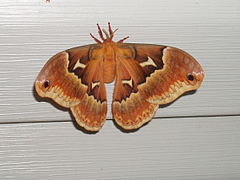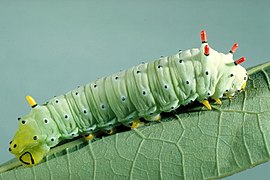Callosamia promethea
| Callosamia promethea | ||||||||||||
|---|---|---|---|---|---|---|---|---|---|---|---|---|

Callosamia promethea , male |
||||||||||||
| Systematics | ||||||||||||
|
||||||||||||
| Scientific name | ||||||||||||
| Callosamia promethea | ||||||||||||
| ( Drury , 1773) |
Callosamia promethea is a butterfly found in North America( moth ) from the family of the peacock moth (Saturniidae). The reason for the choice of the specific epithet has not been clarified beyond doubt. One interpretation, however, is that it goes back to Prometheus , a figure from Greek mythology who, among other things, is a symbol of the freedom and independence of the individual. The connection to the peacock moth seen here is that its cocoon always hangs freely from a branch in a rolled-up leaf.
description
butterfly
The moths reach a wingspan of 75 to 95 millimeters. There is a clear sexual dimorphism between the sexes . The basic color of the upper side of the males is black. The submarginal region is yellowish to ocher colored and crisscrossed by a black wavy line. Discal spots are missing. Below the red-brown apex is a dark eye spot. The females are predominantly red-brown to yellow-brown in color. In the dark brown disk region there is an angled, yellowish disk spot on each of the upper sides of the wing. A circular, dark eye-spot can also be seen at the apex of the forewings. The undersides of all wings show similar drawing elements as the upper sides in a slightly weakened form. The males have very large and strongly combed antennae . With this they ingest the pheromones emitted by the females .
Caterpillar
Young caterpillars are ringed black and yellow-white and have short black hair. Adult caterpillars have a green base color and show black point warts on each body segment. Two red bulges stand out on the 2nd and 3rd segment, and a yellow bulge on the penultimate segment (scolus).
Similar species
The males of Callosamia angulifera are dark red-brown in color and have discal spots. In the females, light red-brown and yellow-gray tones predominate. On the underside of the hind wing, the outer transverse line is pink. The moths of Eupackardia calleta are distinguished by a wide, light-colored postmedial band and the often present discal spots, which are designed in a triangular shape.
Distribution and occurrence
Callosamia promethea occurs in the southeastern Canadian provinces and in the eastern US states as far as Texas . The species prefers to colonize deciduous forests.
Way of life
Due to the climatic conditions in the northern distribution regions, the moths fly in one generation from May to July. The populations living further south form two generations and fly from March to May and August. They do not eat any food. At night only the females visit artificial light sources . They lay the eggs in small groups on the leaves of the food plant. Newly hatched caterpillars initially live gregariously, older ones live individually. The caterpillars feed on the leaves of many different deciduous tree species, and include: Fragrant fever bush ( Lindera benzoin ), sassafras ( Sassafras albidum ), tulip tree ( Liriodendron tulipifera ), Magnolia virginiana ( Magnolia virginiana ), white ash ( Fraxinus americana ) and common lilac ( Syringa vulgaris ). To pupate, the caterpillar reinforces a petiole with silk and then spins its cocoon into the twisted leaf. The cocoon hangs freely from a branch of the host plant during winter. The doll will often of wasps species affected (Ichneumonidae), in particular of Gambrus nuncius and Enicospilus americanus . A study from Maine shows that 59% of the death rate there is due to these parasites.
Individual evidence
- ↑ Gene Kritsky & Ron Cherry: Insect Mythology. Writers Club Press, USA, 2000, ISBN 978-0-595-15017-5
- ^ Butterflies and Moths of North America
- ↑ Stephanie M. Juice & Bernd Heinrich: Overwinter Parasitism of Callosamia promethea (Drury) (Saturniidae) (Promethea Moth) in a Northern Hardwood Forest , Northeastern Naturalist 24 (3), 2017, pp. 317-330



